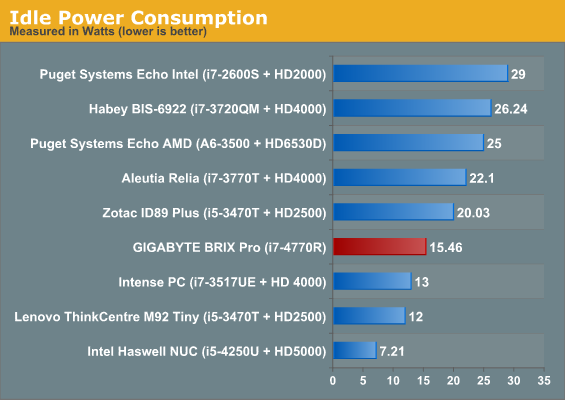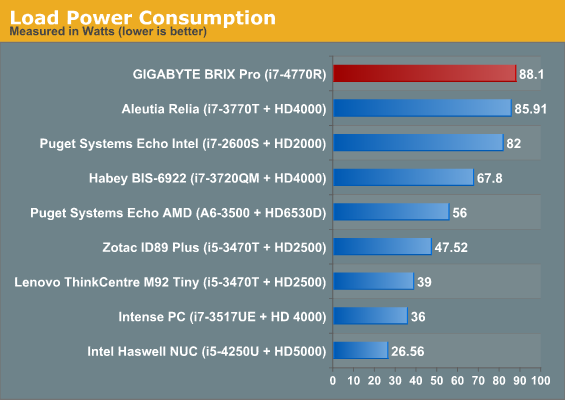GIGABYTE BRIX Pro: A First Look at the Intel i7-4770R with Iris Pro HD 5200
by Ganesh T S on January 7, 2014 8:00 PM EST
The presence of the Core i7-4770R in such a small form factor / chassis left us worried initially. We were wondering whether the unit would be able to properly cool down a 65W TDP processor within those constraints. Due to the size of the system, the fan had to be pretty small and rotate at high speeds for effective cooling. With a maximum speed of 4090 rpm, the sound from the unit was similar to what one would expect in a mini-server room (matching the noise from the Netgear GSM 7352S that we have running in our NAS testbed). While running various benchmarks, the speed topped out around 3900 rpm.
To stress the unit to the maximum, we unleashed our Prime 95 + FurMark stress test and recorded the following numbers.


At the outset, the idle numbers are impressive for a system with a 65W TDP desktop processor. Note that this is not a ULV CPU like what we had in the Intel NUC. The load numbers indicate a maximum power consumption of approximately 88W. I did see the instantaneous power consumption shoot up to 92 - 93W initially and attributed this to the Core i7-4770R's turbo mode (where the CPU clock can go up to as high as 3.9 GHz compared to the nominal 3.2 GHz). A look at the temperatures and HWiNFO throttling information, however, confirmed what we had feared.
Gallery: GIGABYTE BRIX Pro
The unit does seem to throttle under full load of both the CPU and GPU (an unrealistic workload, admittedly, but one which some of the other systems we have evaluated have passed with flying colours). Now, the results that we obtained for the four passes of our x264 benchmark run were pretty consistent. It might turn out that normal workloads don't trigger the throttling and it is something we hope to evaluate further down the road.














98 Comments
View All Comments
mfoley93 - Tuesday, February 11, 2014 - link
The issue with the AMD APUs is that they have used different GPUs accross the line, whereas Intel only has 3 active GPU SKUs. So while the GPU in the 95 Watt A-10 7850 labeled only as R7 would likely smoke Iris Pro/HD 5200, the GPU in the 65 Watt A-8 7600 may only perform similarly to the Iris Pro when it finally launches. AMD using different GPUs may have changed though, since they haven't released the A-4, A-6, and A-8 models yet.mfoley93 - Tuesday, February 11, 2014 - link
EDIT:A quick jaunt over to AMD's website shows that their tendency to use different GPUs has not changed. Even though there is no info about the A-8 7600, one can see that the A-10 7700K has two compute units disabled on the GPU compared to the 7850K.
mikk - Tuesday, January 7, 2014 - link
The GPU is probably comparable or maybe slightly slower than this Iiris Pro. It has more Gflops as well as more bandwidth with its edram.jeffkibuule - Tuesday, January 7, 2014 - link
You need to go read the Iris Pro graphics review again to see why just measuring GFLOPs doesn't give you the result you seem to expect.ryrynz - Tuesday, February 4, 2014 - link
Funny cos, they're gonna make you wait.XZerg - Tuesday, January 7, 2014 - link
I am waiting to see the Zotac IQ01 availability and benches. 4770T in a small enclosure.Daisho11 - Tuesday, January 7, 2014 - link
I really wish they would make one of these with the PSU built in, instead of having a power brick hanging off the back.patterson32 - Tuesday, January 7, 2014 - link
At least it helps with heat minimization. Positive thoughts.MikeMurphy - Tuesday, January 7, 2014 - link
This is a tech site. Instead of telling us the cooling is insufficient, I hope you'll show us the config and explore replacement fans etc. Are the cooling mounts LGA standard?patterson32 - Tuesday, January 7, 2014 - link
I'd like AT to explore quieter replacement fans as well. Fanless cases might be okay too but they'll probably cost a lot compared to the system just like the NUC ones.